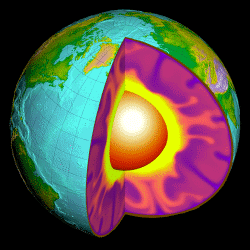Stirring Up a Magnetic Field

Molten iron and nickel oozing within the Earth are thought to generate the magnetic field that points compass needles northward. But despite an elaborate theoretical explanation for the field generation process, researchers have been unable to create a so-called fluid dynamo of their own. Now, after 25 years of work, a Latvian-German collaboration reports in the 8 May PRL that they have finally created a magnetic field the same way the Earth does, providing clear confirmation of the theory.
Many of us have built electromagnets by wrapping wire around an iron bar and attaching a battery. Such a “technical dynamo” is quite different from a fluid dynamo, explains Gunter Gerbeth of the Rossendorf Research Center in Dresden, Germany. “A fluid dynamo has no external source of electrical current,” he says, because it’s a closed system. But under the right conditions, an isolated fluid–when stirred properly–can maintain electric currents and magnetic fields, although the system needs a small “seed” field to get started. The Earth’s magnetic field, for example, is continuously regenerated by electric currents in the swirling molten metal of the outer core, which is trapped between the mantle and the solid inner core.
According to fluid dynamo theory, the flowing liquid stretches and distorts the seed field, which induces electric currents. These currents generate more magnetic field, and the feedback cycle amplifies the field until it reaches a stable level. But the amplification works only if the moving fluid can “grab hold” of magnetic field lines and distort them before they diffuse away. This condition is met if the so-called magnetic Reynolds number is large, which requires that the fluid motion be fast or that the dimensions of the system be large. The slow fluid motion of the Earth’s outer core is fast enough to generate a dynamo because of its large size, but researchers need much faster fluid motion to make a dynamo in the lab.
Gerbeth and his colleagues from Dresden and the Latvian University in Riga initially applied a small seed field externally while stirring a container filled with molten sodium up to speeds of nearly 15 m/s. Thanks to the extremely high conductivity of liquid sodium and a carefully shaped velocity field, this was fast enough; an oscillating magnetic field began to grow in the fluid, and was maintained even with the seed turned off. “Our aim was to demonstrate the very idea of self-generation in the simplest possible flow geometry,” says Riga team member Agris Gailitis. And they did, although Gerbeth notes that “We just barely succeeded.”
“It’s a great breakthrough, and I am very excited,” says Paul Roberts, of the University of California in Los Angeles, who helped develop the mathematical theory of fluid dynamos. He adds that a group in Germany achieved a similar result at about the same time, and others are expected soon. This is an important verification of the idea that dynamos generate the magnetic fields in planets and stars, says Roberts.
–Mark Sincell
Mark Sincell is a freelance science writer based in Houston, TX.


